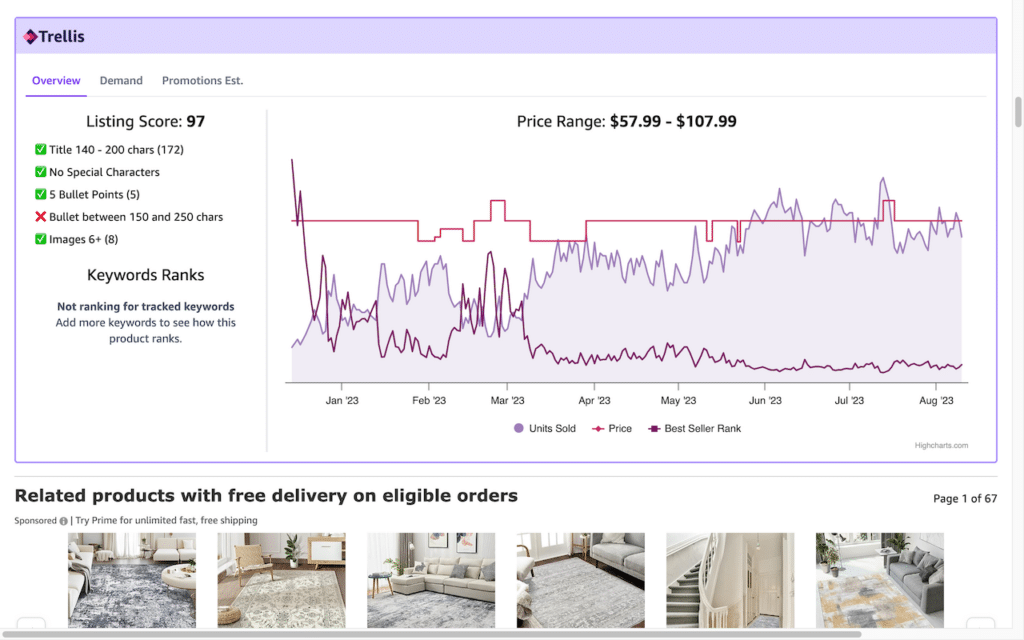Setting a price on Amazon can be tricky. As a company looking to drive sales, you want to price your products high enough to make a profit but low enough to remain competitive in the marketplace. The same can be true for making purchases; when shopping on Amazon, you want to be sure you’re not overspending on a product.
The best way to accomplish both of these goals? Tracking Amazon price history. By keeping an eye on pricing for products you want to buy, or managing products you have for sale, you can ensure you’re making the best choices for your bank account or your business. This is what you need to know about price history on Amazon—and how Trellis can help.
Key takeaways
- Tracking the price history of products on Amazon can be a valuable part of both buying and selling strategies.
- Managing price data without automatic tools can be a cumbersome and inaccurate process.
- Using the Trellis Chrome extension can help manage both pricing business strategies and savings for buyers.
The best way to see Amazon product price history
Keeping an eye on pricing is one of the best ways to succeed on Amazon, whether you’re trying to compete with other businesses selling similar products, or trying to give great deals. Prices fluctuate on a regular basis for many reasons;
- Sellers are trying to take advantage of limited inventory,
- They are offering promos to drive sales, or,
- Prices are raised to mark them down during shopping seasons to receive an attractive strikethrough price.
Without a way to monitor these kinds of behaviors, it’s impossible to be sure you’re either staying competitive with other brands—or keeping your wallet from taking a hit.
However, attempting to do this solo can mean a lot of time refreshing pages and manually tracking information. That’s why the best way to see Amazon product price history is by using tools and extensions that capture data in real time and make it easily available and viewable over time.
The Trellis Chrome extension is an excellent tool for tracking Amazon price history, providing access to consistent information about products. This can include reviewing trends—for example, how to price items on Black Friday or Cyber Monday to ensure increased sales—recording historical data, and getting automatic updates when the landscape changes.
What is a price tracker?
A price tracker is a tool that can be used to automate tracking price changes on Amazon. These programs, which often take the form of browser extensions, monitor changes in product pricing in selected listings and provide consistent alerts, as well as access to historical data when available. Rather than manual checking, which can be tedious and time-consuming, these tools can handle the grunt work, providing comprehensive information about how dynamic pricing can be in a fluctuating marketplace.
How do price trackers work?
Price trackers work by monitoring the product or category pages as selected by a user and logging any changes.
- Users provide a URL or the ASIN of the products they want to be tracked
- Determine how often pages should be checked
- Set a notification method with how changes should be announced.
This is usually done through a pop-up alert, or notification sound in a browser window. Most tools keep logs, too, allowing users to look for monthly or yearly trends when prices are likely to be highest or lowest.
Why should you track price history on Amazon?
Whether you’re a casual shopper or a company that does significant business on Amazon, price tracking is a smart way to manage transactions. These are some of the benefits of tracking price histories on Amazon:
- Examine the state of the market in the niches in which you sell.
- Determine how much sellers with similar products are charging.
- Learn how to be competitive with sales and deals.
- Make strategic pricing choices to maximize profit.
- Explore trends to analyze whether turning a profit with your products is possible.
- Vet the potential for new products within the current marketplace.
How to use the Trellis Chrome extension to track Amazon price history
If tracking is your goal, particularly with business growth in mind, the Trellis Chrome Extension for Amazon sellers is a key way to help your brand succeed. With features ranging from price tracking to detailed analytics, our free resource adds significant value to your operations.


- To start using Trellis’s advanced suite of tools, the first step is downloading the extension. When finished, the extension should be visible in the extension menu within Chrome.
- Once you have downloaded the extension, you will be prompted to sign up for an account, which will require entering your business name, email address, phone number, and any referral information.
- Optionally, you will be able to sync your Trellis account with the Amazon seller account.
- Once signed into Trellis, start viewing price history by searching for products using keywords or ASINs. It will provide extensive information directly within Amazon’s search or product listings.
- The tools that appear on each page can provide you with an array of information, as depicted in the above screenshots, allowing you to view things like price ranges and historical data.
For those who want more detail, that’s available, too. Users can delve into stats like BSR and estimated product sales to see how price is affecting competitors’ bottom line. You can also get a snapshot of the product’s listing health and common advertising keywords. This data is vital for businesses of all sizes, regardless of the depth and breadth of Amazon sales.
Other ways of checking Amazon product price history
While the Trellis Chrome extension is an excellent way to stay on top of changes to prices across Amazon, there are other tools available that buyers and sellers may consider. Websites that are focused on price tracking and history can often help you activate the data into more profit or sales.
Extensions
Many extensions work in the same fundamental way—providing real-time price updates based on a pre-set tracking schedule—but many are solely focused on price tracking, making it difficult to see how price interacts with other variables. For those with sales growth targets, an extension with a narrow focus might not be enough.
- When considering extensions, it’s important to evaluate which ones are more general versus ones that offer specific tools.
- Picking the wrong extension can mean leaving money on the table and closing doors on data collection and analytics options focused on making sales.
- If you’re opting for a paid extension instead of Trellis, ensure you have a workflow to incorporate it. Only pay for tools that will generate profit growth.
Platforms
Some platforms integrate price-tracking into their algorithms to support price changes. With these kinds of websites, there’s no need to download anything; all information is available within the website interface. For those who want to change their price regularly, paying for this type of offering may be worth it.
One of the largest drawbacks of these kinds of products is cost. Users need enough products and advertising spend supporting these price changes to make ROI.
Full-service platforms like these may provide a more streamlined way to take advantage of price changes, particularly for those who aren’t data-savvy, making this a frequent choice for business owners sparse in specialized employees.
Make informed decisions with Trellis
Whether you’re trying to save money or want to grow your business, the Trellis Chrome extension provides a comprehensive toolkit to augment your pricing analysis. With tools for examining sales trends, refining keywords, and analyzing the competition. More expansive than other Amazon price history trackers and often easier to use, there’s no reason to consider the alternatives.
In addition, the Trellis Chrome extension is free to install, providing an extensive suite of tools without a financial commitment. And, as an introduction to what Trellis can do, it’s easy for brands to transition to our automated platform as your business grows and your needs expand.
With Trellis, profit growth is always within reach. Contact us today to learn more.



